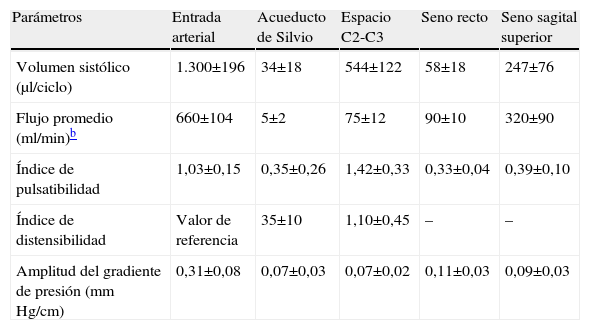Estimar las relaciones dinámicas entre los fluidos craneoespinales (líquido cefalorraquídeo [LCR] y sangre) en el espacio ventricular, subaracnoideo cerebral y subaracnoideo espinal mediante la cuantificación de imágenes de resonancia magnética (RM) en contraste de fase.
Material y métodosSe analizaron 15 sujetos voluntarios sanos en la misma franja horaria y bajo la misma intensidad de campo (3T). Para cada estudio se realizaron 4 exploraciones en contraste de fase: 2 secuencias para el cálculo de LCR (acueducto de Silvio y espacio perimedular C2-C3) y 2 para el cálculo del flujo sanguíneo (arterias carótidas internas y vertebrales, seno sagital superior y recto). En todos los sujetos se calcularon los parámetros de amplitud (volumen sistólico, flujo promedio, índices de pulsatibilidad y distensibilidad, amplitud del gradiente de presión absoluta y relación de volumen de fluido de LCR por ciclo) y temporales (retrasos frente a la entrada de flujo arterial).
ResultadosRespecto a la entrada de sangre arterial, el desplazamiento de sangre venosa (al 22 y 38% del ciclo cardíaco en los senos recto y sagital superior, respectivamente) y del LCR (al 12 y 25% de ciclo cardíaco en el espacio perimedular C2-C3 y el acueducto de Silvio, respectivamente) describen la distribución de la pulsatibilidad de los fluidos intracraneales. Se obtienen índices de distensibilidad para los compartimientos encefálico y medular en una población normal.
ConclusionesMediante los mapas de velocidad de flujo obtenidos con RM es posible describir de manera cuantitativa las relaciones dinámicas de los fluidos intracraneales e inferir el comportamiento elástico encefálico y medular.
To estimate the dynamic relations between cerebrospinal fluid (CSF) and blood in the cerebral and spinal subarachnoid spaces and in the ventricles by quantifying phase contrast magnetic resonance imaging (MRI).
Material and methodsWe analyzed 15 healthy volunteers during the same time of day and using the same magnetic field strength (3T). Each study consisted of four phase contrast sequences: two to calculate the CSF (aqueduct of Sylvius and the C2-C3 perimedullary space) and two to calculate the blood flow (internal carotid and vertebral arteries, superior sagittal sinus, and straight sinus). We calculated the amplitude parameters (systolic volume, mean flow, pulsatility and compliance indexes, absolute pressure gradient, and ratio of CSF volume per cycle) and temporal parameters (delays respect to arterial flow).
ResultsWith respect to the input of arterial blood, the displacement of venous blood (22% and 38% of the cardiac cycle in the straight sinus and superior sagittal sinus, respectively) and of CSF (12% and 25% of the cardiac cycle in the C2-C3 perimedullary space and in the aqueduct of Sylvius, respectively) show the distribution of the pulsatility of the intracranial fluids. We calculated the indexes of compliance of the encephalic and medullary compartments in normal subjects.
ConclusionsIt is possible to quantitatively describe the dynamic relations between intracranial fluids and infer the elastic behavior of the brain and spinal canal by using flow velocity maps obtained with phase contrast MRI.
Artículo
Comprando el artículo el PDF del mismo podrá ser descargado
Precio 19,34 €
Comprar ahora











